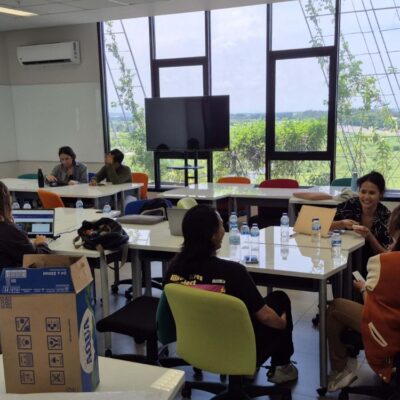During the COVID-19 pandemic, *Ling (not her real name)—a personal care assistant of Chinese descent in an aged care facility—experienced increased racism in her everyday life in Australia, both at work and in public. Ling’s experiences of racism included being ignored by staff at supermarkets, and accusations by shoppers of hoarding goods to send to China (likely fueled by fake media stories at the time). In the street, she faced verbal abuse and was told to ‘go back to her country’. The racism also impacted her child who experienced refusals to play from other children, because of the ‘China Virus’ and the racist bias associated with that term.
Due to attacks on Asian women—who overwhelmingly experienced most of the anti-Asian physical and verbal harassment—Ling was fearful of going out in public, catching public transport and visiting the city near her home. In her workplace, Ling experienced increased aggression and racist comments from residents, and her non-Asian colleagues, associating her with the virus from China.
Similarly, *Jeni (not her real name)—an aged care worker of Chinese descent—experienced increased aggression and discrimination during the pandemic. Jeni’s experience of racism from residents in the aged care facility where she worked, their families and from co-workers, was not unfamiliar, as she commonly experienced discrimination in the aged care environment, even prior to the pandemic.
Endemic racism in the aged care sector
Recent research conducted by Dr Bola Adebayo, Dr Pam Nichols, Associate Professor Karen Heslop from Curtin University, and Professor Bianca Brijnath from the National Ageing Research Institute explored the perceptions of migrant care workers in relation to their job demands, their coping strategies, and employment intentions. They found that aged care workers of Asian and African descent experience racism because of the colour of their skin, their accented English, and their cultural approaches to care.
Research conducted by the first author of this article (Dr Winarnita) together with Dr Masa Higo, Assistant Professor Thomas R. Klassen, and Professor Irene Blackberry prior to the pandemic explored the experiences of Asian women—that is, women from North, South and Southeast Asia—working in aged care, focusing on their well-being and the factors they used to cope, adapt, and transform during times of crisis. Our research highlighted some of the ongoing challenges faced by aged care workers from migrant backgrounds, such as racial discrimination, a lack of intercultural understanding and awareness, and precarious employment conditions. For women of Asian descent who work in aged care, additional challenges impact their wellbeing, such as the gendered and racialised negative stereotyping of Asian women. Even so, essential support for the wellbeing of aged care workers is often lacking, particularly for those from Culturally and Linguistically Diverse Backgrounds (CALD), such as those of Asian descent in Australia.
A recent conference presentation by Professor Eleanor Holroyd and Associate Professor Sharyn Graham Davies on behalf of their team, with the first author Dr Winarnita, highlighted similarities between the pandemic experiences of Asian women working in aged care in Australia, and CALD women working in aged care in New Zealand. What we found was that the experiences of both groups of women reflected structural inequality, racism, and feminised care labour. Asian women in the Australian aged care workforce were targeted during the pandemic because of their appearance: for not only being Asian but also for being perceived as small and weak, as Asian women tend to be physically small and look younger than they are. In New Zealand, aged care workers from CALD backgrounds experienced discrimination, racism, and aggression in public during the pandemic, and were targeted because they were wearing their healthcare uniforms.
Both Asian women working in aged care in Australia and CALD women working in aged care in New Zealand experienced an intensification of their workloads, and for New Zealand healthcare workers in all settings, including aged care, there was additional pressure—for them to be a ‘hero’, to ‘do their duty’ and be a ‘good carer’. Even so, there was little real recognition of their efforts, and healthcare workers were left feeling deflated and undervalued, with doubts about whether or not they wanted to continue working in the healthcare sector.
As caregivers to their families, Asian women in the aged care workforce like Ling and Jeni balanced work and family life during the pandemic. They managed COVID-19 infections, providing care for others in their workplace and in their homes as spouses and mothers, as well as transnational care of ageing parents and extended family when the crisis was worse overseas in China, India and Indonesia.
For Asian aged care workers in Australia, the media reporting of COVID-19 as the ‘Wuhan Virus’ or ‘China Virus’ further contributed to experiences of discrimination and xenophobia. In Australia, there were reports of anti-Asian racism, with Asian healthcare workers experiencing targeted racist behaviour. Research conducted by Dr Sylvia Ang, Associate Professor Jay Song & Dr Qiuping Pan highlights the existing intersection of sexism and racism in Australia during the pandemic, as Asian women received more racial abuse than their male counterparts. The racism experienced by Asian women in the aged care workforce in Australia during the pandemic was an intensification of endemic racism and common Asian-Australian experiences of discrimination.
Workload demand, discrimination and additional stressors during the pandemic
During the pandemic, Asian women in the aged care workforce such as Ling and Jeni also experienced increased workload demand in their roles as essential workers and as care-givers to their families.
Workload demand is common in the aged care sector, and a report by the Royal Commission into Aged care Quality and Safety (2018-2021), found that there is a need for three times more workers in the aged care sector than are currently employed. While migration is often posed as the solution to the aged care staffing crisis, current migration numbers are unlikely to meet the demand. Importantly, increased migration will not address issues faced by workers of Asian descent in Australia, such as structural inequality and endemic racism.
Online connections were critical to the support of aged care workers during the pandemic
During the pandemic, aged care workers in Australia, most of whom are women, were classified as essential workers, providing valuable ‘life support’ to the most vulnerable members of society. But what resources did they themselves draw on for ‘life support’ in this time of crisis? What were their motivations for working? What were their challenges, both in the workplace and outside, and who or what supported them?
A follow-up to the study by the first author and co-authors on the experiences of Asian women working in aged care (mentioned above) showed that, in the face of pandemic challenges such as social isolation, they negotiated a sense of belonging, locally and transnationally, through online support networks. For example, aged care workers from Indonesia in Australia used online chat groups to share their experiences of racism, such as in supermarket settings, using humorous memes as a coping mechanism, for example a popular meme from ‘The Handmaid’s Tale’ (a drama series based on the book by Margaret Atwood), where Handmaidens meet at the supermarket, was adopted, and contextualised by aged care workers to their own circumstances. The women chatted online in a humorous way about what they might wear to the supermarket to hide their racial features such as sunglasses, hats and face masks. They joked about the potential of meeting each other in a particular aisle, and co-ordinating their outfits so they would recognise each other. In this way they made light of a tense situation. Sharing memes in a group chat and relating it to their situation was one of the main ways the women found support during social isolation and lockdowns. Through engaging in shared experiences, they found ways to cope and adapt to challenging and difficult situations.
Transnationally, during the height of the Delta outbreak in Indonesia, Indonesian women working in aged care in Australia used the messaging service WhatsApp to send messages of support to family and friends in Indonesia. They used their Indonesian social networks in Australia to communicate their shared experiences of family and friends who had COVID-19 or had passed away from COVID-19. This helped them to cope and adapt during a time of crisis. This reflects recent research on the use of technology by migrants in Australia to care at a distance and the meanings attached to it during and prior to the pandemic.
Support networks help Asian women working in the aged care sector to cope and adapt
The ability to cope and adapt during a crisis are indicators of social resilience. Asian women working in aged care in Australia drew on their networks to help them to overcome challenges and build social resilience, both in the community and the workplace.
For example, in research conducted by the first author of this article (Dr Winarnita) prior to the pandemic, *Priya (not her real name), a woman and aged care worker of Indian descent, had difficulties adapting to the different cultural values she encountered in her workplace when she first started working in aged care in Australia. Residents in aged care settings can feel uncomfortable being cared for by someone from a different racial background, and racism is common in aged care in Australia. On one occasion, Priya’s manager was advised by some workers of her co-workers to not hire people from non-English speaking countries, because, the co-workers believed, they couldn’t understand instructions. On another occasion, two co-workers accused staff from other countries of taking ‘their’ jobs.
On both of these occasions, Priya was supported by her manager who responded to the co-workers, highlighting that all workers at the facility had the same skills and qualifications, and that the aged care facility cannot stop hiring workers of different nationalities. Drawing on the support of her manager and her Asian colleagues, Priya felt she could continue working at the aged care facility, despite the difficulties she encountered.
In addition, Priya was able to draw on another form of ‘life support’ in relation to her social capital; Priya was university educated, had Permanent Residency status and a history of regular, long-term employment in the aged care sector. Even though she had experienced challenges, Priya expressed a desire to continue working in aged care and envisioned a long-term career using her skills and qualifications.
The needs of Asian women in the aged care workforce
While Priya and other Asian women in the aged care workforce, like Ling and Jeni, experience racism and a lack of cultural awareness in their workplace, they nonetheless value the employment opportunities available to them in the aged care sector and have long-term career goals. However, they recognise they need forms of ‘life support’ to continue working.
Asian women working in the aged care sector like Ling, Jeni and Priya need skills training, including in relation to language barriers and understanding the cultural differences of their residents. They need a supportive work environment where the staff work together as a team, with networking opportunities. They also need supportive managers, such as Priya was able to draw on, and opportunities for ongoing professional development.
Importantly, aged care workers like Ling, Jeni and Priya need to be paid a salary that is commensurate to their responsibilities. Aged care staff, the majority of whom are women, are notoriously under-paid. Recently, following a decision made by Australia’s Fair Work Commission, personal care workers and those working in home care received a 15 percent wage rise.
The stories of Ling, Jeni and Priya highlight the experiences of Asian women generally who work in the aged care sector in Australia. They reflect the endemic racism and social stigma that is present in the Australian aged care sector. Focusing on the experiences of Asian women working in aged care provides a gendered and racialised understanding of the types of ‘life support’ needed—not only during a crisis, but to address ongoing workplace issues relating to racial and gender discrimination, intercultural understanding, and employment precarity. It also highlights the potential opportunities for building social resilience and provides insight into how society and communities can support the wellbeing of aged care workers. These understandings can help to ultimately address endemic issues around quality of care in diverse and aging communities in Australia.
Authors: Dr Monika Winarnita and Dr Carmela Leone
The authors would like to acknowledge funding by the Deakin Sociology and Social Change Research Group for the follow up research published in this article.
*Pseudonyms are used throughout
Main image credit: Cedric Fauntleroy/Pexels.




